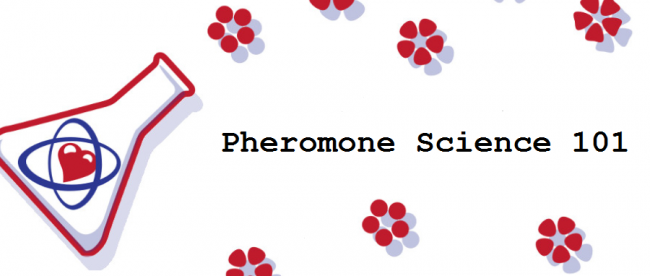Pheromone Science 101: How Exactly Do They Work?
Interested in the science behind pheromones? There are a lot of articles and research papers out there with competing views on pheromones, but we decided to boil everything down to the basics and show you how pheromones work without too much of the dense and wordy techno-babble that make so many research papers hard to understand. We firmly believe in the power of pheromones and the science that backs it up, and after reading this article, hopefully you will too!
What are pheromones?
The word “pheromone” was coined by researchers in the 50s and is derived from the Greek words “pherein” (to carry) and “hormon” (to excite). Basically, pheromones are chemicals that carry messages that can evoke sexual and social responses from other members of the same species. In many animals, this response is easy to see. For instance, when introduced to the pheromones of a male rat, female rats will raise their rear ends in a mating posture.
In humans, responses to pheromones have been a bit harder to research because they are a bit more complex than the basic sexual responses of most animals. Before the 1990s, most scientists didn’t even believe that humans have a vomeronasal organ (VNO), which is the organ found in the noses of most mammals that allows them to detect and respond to pheromones. In the 90s and beyond, researchers proved both that humans have a VNO and that the human VNO can detect even tiny amounts of pheromones [1].
In the years since then, scientists have found evidence that our sense of smell can detect and respond to chemical signals given through body odor and pheromones. For instance, human female pheromones can regulate ovulation in other women [2] and human male sweat (where some pheromones naturally occur) can change the mood and hormone levels in women [3].
What are the differences between specific pheromones?
New pheromones produced by humans are being discovered every year, but most pheromone studies have looked at two of the most commonly used pheromones: AndrosteNONE and AndrosteNOL. These chemicals are produced by humans in our bodily fluids, and can be synthesized for use in pheromone products. Pheromone users and researchers report many differences between these pheromones. In later articles, we will focus on specific pheromone chemicals and the differences between them. Here are a few examples of research into specific pheromone chemicals.
Studies have shown that androsteNOL can cause women to see men as more attractive than they normally would. In one study, researchers gave androsteNOL covered necklaces to 38 men and 38 women to wear while they slept. The next day, researchers found that women who wore the necklace had noticeably more contact with men [4]. Another study found that when people are under the influence of androsteNOL, they rated photos of women as more attractive and they rated photos of men as friendlier and warmer [5].
AndrosteNONE is slightly less well researched, but one study in particular found that AndrosteNONE affects how women emotionally evaluate men [6]. This study also found that women react more positively to AndrosteNONE while they were ovulating.
There’s still a lot to learn
Overall, scientists still have much to learn about pheromones and their role in human sexuality. Research into human pheromones was not even taken seriously until the 90s, and in the coming years there will be many interesting new finds.
Make sure to keep reading our blog (we recommend starting with the Pheromone Science section) for more information on pheromone science and how pheromone users can maximize their value. If you have any new research articles you’d like us to talk about, let us know in an email or in the comments!
###
References
1. Monti-Bloch L, Grosser BI. Effect of putative pheromones on the electrical activity of the human vomeronasal organ and olfactory epithelium. J Steroid Biochem Mol Biol 1991; 39:573-82.
2. Stern K, McClintock MK. Regulation of ovulation by human pheromones. Nature 1998; 392:177-9.
3. Preti G, Wysocki CJ, Barnhart K, Sonheimer SJ, Leyden JJ. Male axillary extracts effect lutenizing hormone (LH) pulsing in female recipients. Poster presentation at the 23rd Association for Chemoreception Sciences Annual Meeting; 2001.
4. Cowley JJ, Brooksbank BWL. Human exposure to putative pheromones and changes in aspects of social behavior. J Steroid Biochem Mol Biol 1991; 39:647-59.
5. Kirk-Smith M, Booth DA, Carroll D, Davies P. Human social attitudes affected by androstenol. Res Comm Psychol Psychiat Behav 1978; 3:379-84.
6. Grammer K. 5 alpha-androst-16-en-3-one: A Male Pheromone? A Brief Report. Ethol Sociobiol 1993; 14:201-8.
These statements have not been evaluated by the Food and Drug Administration. These products are not intended to diagnose, treat, cure, or prevent any disease.


Leave a comment
You must be logged in to post a comment.